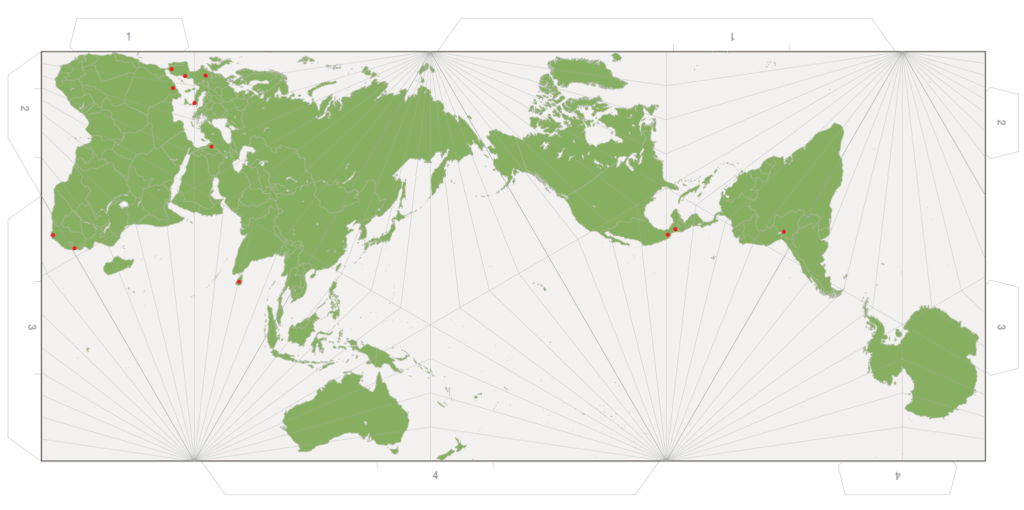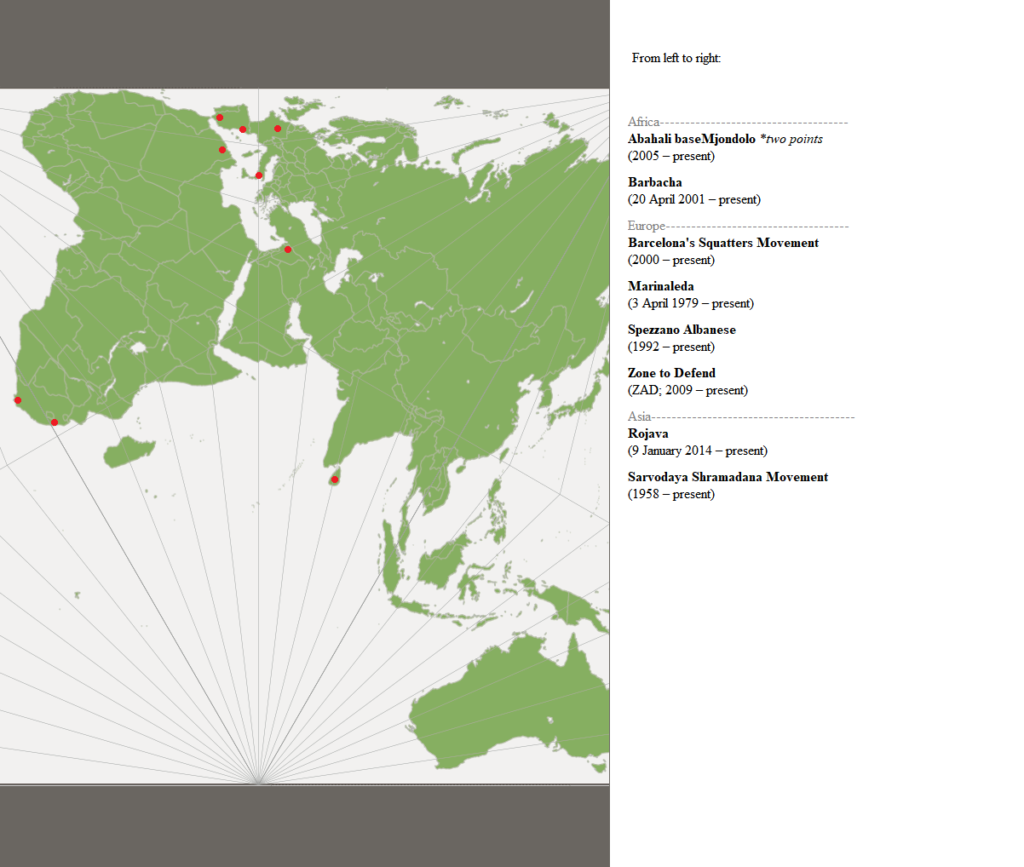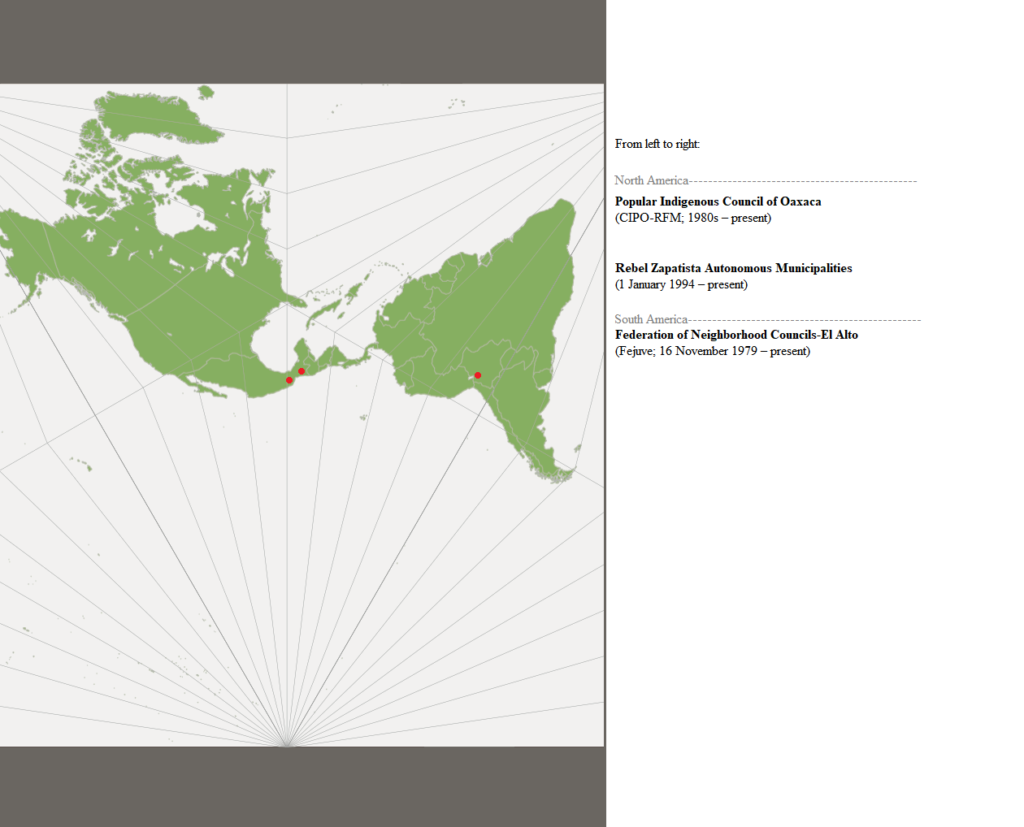Idea:
Map several active non-state mass societies.
Why:
The exclusion of non-state and anti-state perspectives from conventional political discourse produces an incomplete ideological spectrum which naturalizes the presence of the state.
Some issues to report:
Group Representation–
A. Present or past and present – There are many concluded anti state experiments so it was a decision to start the project with a few active communities. By including past communities, a great deal of information regarding the trajectory of these ideas would be clarified in some instances, but wildly complicated in others.
B. Representation – The issue of uniting, through representation, stunningly diverse communities belonging to a loosely unified group marker(s). The issues of representing communities with a tendency not to represent themselves in concrete terms is something of an obstacle for practical and ethical reasons. Committing to a principle articulated by Jennifer Guiliano and Carolyn Heitman (Difficult Heritage and the Complexities of Indigenous Data, 2019), I intend to recognize “multiple ecosystems … related to data that must exist simultaneously and be treated as part of a nonhomogeneous whole.”
C. Misrepresentation – Running the risk of misrepresenting groups who are ambiguously aligned with anti-state sentiment. In some cases communities are not explicitly anti-state, but apolitical. It seemed better to separate out these distinctions than to run the risk of misrepresentation. At the same time, these exclusions risk misrepresenting groups that disregard that technicality.
Data Representation–
A. What do I want the data to reveal beyond merely presenting the existence of these groups?One of my goals is to represent connectedness of groups as something rhythmic and more contingent than what is expressed by legal or linguistic formalities that too often misrepresent reality and encumber human agency. For this reason, I’ve included an information sheet. It can be found below, with the title “Active, non-state mass societies on map”
B. What elements of the data should be privileged to make this point?
– Population size, which would appear to be an obvious choice, proved to be an unskillful measurement in the context of this study. The choice to define the scope and domain of subject groups’ internal membership with a light touch prompted my use of the intentionally vague term “community” in favor of the prototypical population count. This decision is in some instances attributable to a group’s voluntarism, and in others representative of a non-paradigmatic conception of sovereignty.
– Customs similarly seemed to miss the mark by giving the impression that non-state organization is specific to a particular society, place, or time, though in fact it is a ubiquitous cultural legacy. Equally problematic is the potential for the term “custom” to obscure the unique traditions, events, rituals and genuine customs shared within the group – as well as between one group and the society in which it is contained. For these reasons, the term “praxis” is used to denote the synthesis of theory and practice apparent in each group’s methods. This way, the data presents cultural distinction and methodological similarity without presuming the primacy of either.
– Genealogy is used to indicate grounding principles and relevant ideological connections, with the risk of oversimplification hopefully outweighed by the benefit of concise reference points.
C. Names and figures
The data is not necessarily uniform across multiple sources. When employed, averages and editorial decisions must be noted to preserve transparency.
Technical Limitations and Choosing Software –
A. QGIS –——-
My first inclination was to utilize open source software. I downloaded QGIS, for which the CUNY Graduate Center offers workshops, and immediately realized the software was too advanced for my current understanding. I switched to Tableau, which appears to function much more intuitively and offers web-based training videos.
B. Tableau –——-
b1. Working with Tableau Desktop software, I must first create an Excel spreadsheet because I am compiling my own data “set” from textual resources. Importing my data with the software is easy enough but I’ve now entered a labyrinth of software-particular jargon. Additionally the Tableau training videos are less than helpful in the context of applying my own data, which doesn’t meet the software’s standards. I begin to experiment and make some progress but choose to abandon Tableau upon realizing the software will not meet my standards for cartographic representation.
b2. My chosen map template, based on the AuthaGraph World Map, is less than compatible for use in Tableau — The software’s process for working with longitude/latitude coordinates clashes with the design of the AuthaGraph map projection. This is a non-starter for me, for reasons I will explain below.
C. Static Map –——-
I choose to create a static map and use slides for detail, rather than interactive mapping software.
Mapping Process –
A. Using AuthaGraph World Map as a template.
The Authagraph mapping projection, invented by Japanese architect Hajime
Narukawa in 1999, was selected by the Japanese National Museum of Emerging
Science and Innovation (Miraikan) as its official mapping tool in 2011 and
awarded the 2016 Good Design Grand Award from the Japan Institute of Design
Promotion.
According to the project website (authagraph.com) The map is “made by equally dividing a spherical surface into 96 triangles, transferring it to a tetrahedron while maintaining area proportions, and unfolding it onto a rectangle … The map substantially preserves sizes and shapes of all continents and oceans while it reduces distortions of their shapes, as inspired by the Dymaxion map. The projection does not have some of the major distortions of the Mercator projection, like the expansion of countries in far northern latitudes, and allows for Antarctica to be displayed accurately and in whole.” My image was sourced from (http://narukawa-lab.jp/archives/authagraph-map/)
My decision to use this map projection comes from a desire to represent space with minimal distortions, wary of the interplay between cartographic and ideological reproductions.



——- Active, non-state mass societies on map ——-
Sarvodaya Shramadana Movement (1958 – present)
Community: Programs active in some 15,000 (of 38,000) villages in Sri Lanka. Approximately 11 million individual beneficiaries.
Praxis: Self-governance, village councils; collective labor, distribution of group funds; building schools and clinics; family and conflict resolution programs; starting a village bank and offering support to other villages.
Genealogy: Buddhist tradition, Gandhian Anarchism
Federation of Neighborhood Councils-El Alto (Fejuve;16 November 1979 – present)
Community: 600 neighborhood councils in El Alto, Bolivia.
Praxis: Self-governance, provincial councils, consensus; worker’s self-management and common ownership; conflict resolution/ restorative justice; providing public services, water connections, sewerage outlets, electrical cables and garbage collection services; building parks, grade schools, clinics, housing, a public university and work cooperatives.
Genealogy: Aymara traditions, Revolutionary Syndicalism, Anarchism
Marinaleda (3 April 1979 – present)
Community: 2,778 inhabitants; the whole municipality of Marinaleda, Seville province, in the autonomous community of Andalusia, Spain.
Praxis: Municipal councils; communal property, agricultural cooperatives, trade unionism, full employment; grants for home construction, voluntary public services.
Genealogy: Social Democracy, Revolutionary Syndicalism, Anarchism
Popular Indigenous Council of Oaxaca (CIPO-RFM; 1980s – present)
Community: Twenty-six rural communities in Oaxaca, Mexico
Praxis: Self-governance, participatory democracy and consensus, autonomous communities; common ownership of land, environmental protection, sabotage and direct action against private industry; worker cooperatives, building schools and hospitals, maintaining a network of autonomous community radio stations, educational outreach programs; political representation of 26 different, mainly indigenous, communities including Chatino, Mixtec, Chinantec, Cuicatec, Zapotec, Mixe, and Trique peoples.
Genealogy: Green Anarchism, Anarcho-Communism
Spezzano Albanese (1992 – present)
Community: 6,990 inhabitants; the whole municipality of Spezzano Albanese, Cosenza Province in Calabria, Italy.
Praxis: Dual power alternative to the local government, participatory democracy; fund raising for the development of local worker cooperatives and trade unions.
Genealogy: Anarchism
Rebel Zapatista Autonomous Municipalities (1 January 1994 – present)
Community: 363,583 inhabitants; 55 separate municipalities organized into 5 regions (currently expanding as of October 2019)
Praxis: Self-governance, autonomous councils, participatory democracy, consensus; sabotage and direct action against state encroachment; promotion of education, health and arts (especially indigenous language and traditions); worker cooperatives, family farms and community stores; providing low-interest loans, free education, radio stations, universal health-care; self-reliant economics, agricultural production; common ownership of land, participation in international markets.
Genealogy: Mayan tradition, Feminism, Marxism, Anarchism
Barbacha (20 April 2001 – present)
Community: 30,000+ inhabitants; 34 separate villages in the Kabylie region, Algeria
Praxis: Dual power alternative to the local government, democratic assemblies modelled off traditional village councils; sabotage and direct action against local courts, government offices, political party offices, and police stations; councils coordinate further protests, garbage collection, fuel distribution, cleaning, welfare programs and maintenance for local schools and public services.
Genealogy: Amazigh tradition, Anarchism
Abahali baseMjondolo (2005 – present)
Community: 25,000+ active supporters in 64 different shack settlements across Durban, Pietermaritzburg and Cape Town, South Africa
Praxis: Dual power institutions, direct democracy; direct action such as land occupations and self-organized water and electricity connections; tactical use of state courts to overturn laws unfavorable to shack settlements; mutual aid projects like community kitchens and vegetable gardens; dismissal of party politics, campaigns for public housing, occupation of unused government land.
Genealogy: Marxism, Mutual Aid
Barcelona’s Squatters Movement (2000 – present)
Community: Thousands of inhabitants; around 200 squatted buildings and 40 social centres across Barcelona, Spain
Praxis: Squatting, anti-work philosophy; freely fixing up houses, cleaning, patching roofs, installing windows, toilets, showers, lights and kitchens; pirating electricity, internet and water; providing social services to the surrounding residents, including bicycle repair workshops, carpentry workshops, self-defense classes, free libraries, community gardens, free meals, computer labs, language classes, theatre groups, free medical care and legal support services; Helping elderly residents avoid eviction; organizing protests.
Genealogy: Anarchism, Mutual Aid
Zone to Defend (ZAD; 2009 – present)
Community: Between 10 and 15 ZADs across France; no official figures.
Praxis: Squatting, voluntary organization, maintaining permanent villages as blockades to development projects; sabotage and direct action challenging large infrastructure projects in defense of the environment; demonstrations to protect the biodiversity of the wetlands; mutual aid projects, community farming and business.
Genealogy: Environmentalism, Anarchism
Rojava (9 January 2014 – present)
Community: 2 million+ inhabitants in the Kurdish region of northern Syria
Praxis: Dual power alternative to regional governments, federal system, direct democracy, municipal governance, local civic councils; community ownership, workers cooperatives; “co-governance” policy in which each position at each level of government in the region includes a female and a male; promoting decentralization, gender equality, environmental sustainability and pluralistic tolerance for religious, cultural and political diversity; oil, food and agricultural production.
Genealogy: Transnationalism, Feminism, Anarchism


